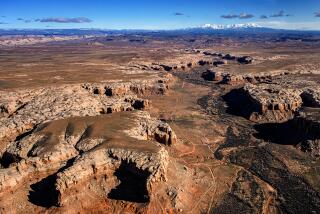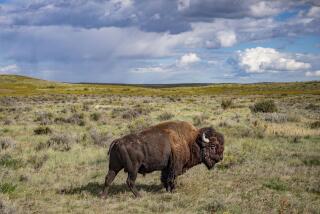Prairie a Home Where Buffalo Roam Under Watchful Eyes of Science : Kansas: The Nature Conservancy, a nonprofit group, owns the Konza preserve, which is managed by Kansas State University. Site has become a tourist attraction, which has created problems.
- Share via
MANHATTAN, Kan. — When Jim Reichman learned there would be a buffalo roundup on the Konza Prairie, he expected to mount a horse and herd the shaggy behemoths across the rolling grasslands.
Was he surprised.
“How they do it is to put food in the back of a pickup truck and honk the horn,” said Reichman, one year into his job as director of the Konza Prairie Research Natural Area. “I thought, ‘That’s not very romantic.’ ”
The 8,616-acre Konza Prairie isn’t just a place for sentimental reveries about courageous settlers and Indian buffalo hunts. Never mind the towering bluestem, fields of waving prairie flowers and vistas of the green, flat-topped Flint Hills.
The Konza actually is a laboratory.
When a pregnant buffalo died near a grove of hardwoods in October, 1992, coyotes weren’t the only ones to pick over the bones. An assortment of academics have pored over the site.
One researcher discovered how certain insect larvae made marks in the bones, marks that archeologists had been interpreting as signs that such bones had been used for tools.
The Konza lies in Riley and Geary counties in northeast Kansas, north of Interstate 70 and west of Kansas 177.
It is dominated by native tallgrass prairie, which once extended from Illinois north and west to the Dakotas and south to Texas. Most of the prairie was converted to farmland, but most of the Flint Hills remained unfarmed because of their steep slopes and rocky soil.
The Nature Conservancy, a nonprofit, private group, owns the land, which is managed by Kansas State University’s Division of Biology. Its annual operating budget of about $180,000 comes from the university, the Kansas Agricultural Experiment Station, the state and user fees.
About $6 million in grants support current research.
The prairie teems with life. About half of all flowering plants in the Flint Hills region--about 525 species--are present on the Konza, as are 100 species of non-flowering plants. There are also 19 species of fish, nine species of amphibians, 25 species of reptiles, 209 species of birds, and 34 species of mammals.
The Konza has become a tourist attraction as well.
Reichman says thousands come to the prairie yearly to take one of three self-guided hikes ranging from 2.8 to 6.1 miles.
But the primary purpose is research, not tourism.
“We don’t have the facilities,” Reichman lamented as he stood on a breezy hilltop overlooking a herd of grazing bison. “Right now we’re simply swamped with people coming out here.
“We’re becoming victims of our own success.”
The Konza is the largest tallgrass prairie designated for research instead of preservation.
“There are places that are bigger, or have more bison,” Reichman said. “But we have 20 years of data. Nobody’s going to scoop us on that. The value of this is only going to go up.”
The Nature Conservancy’s ownership of such a research facility is rare, said Alan Pollom, the group’s state director.
“We are interested in preservation as our primary purpose,” Pollom said. “At the same time, we have an ever-increasing respect for the value of this basic research that allows us to understand how the living world around us works.”
Because the Nature Conservancy could never acquire enough good examples of ecosystems to preserve them on a large scale, it values research that will help those who do own land to take better care of it, Pollom said.
He calls the Konza “the preeminent prairie ecology research center in the world.”
In addition, several federal agencies, including the Interior and Energy departments, use the prairie for research. The U.S. Geological Survey uses water in King’s Creek, which originates on the Konza, as a benchmark for water purity. The National Aeronautics and Space Administration picked the Konza as a site for an experiment involving satellites.
Much of the research relates to the effects of fires and to the 215 bison that roam 2,500 acres.
Biologists conduct other experiments as well. Reichman is studying the effects of underground pocket gophers on vegetation above ground. One student is studying how buffalo scatter the plant seeds they pick up in their beards.
Across the prairie, devices measure water flows. Plywood blinds let researchers spy on mating prairie chickens. Instruments measure rainfall.
The Konza is in the midst of a three-phase development. The first phase, creating a master plan, is nearly done. The National Science Foundation paid for the plan and is contributing about $500,000 for the second phase, which involves renovating a historic limestone house and barn, buying new fire equipment and revamping the bison-handling facility.
The third phase deals with public access as well as research. More than $2.4 million will be needed to upgrade the nature trail and build an environmental education park, as well as build a new lab and living quarters for visiting researchers.
Those visitors, who come from around the world, now bed down in the old stone house. It was designed as a cowboy bunkhouse.
More to Read
Sign up for Essential California
The most important California stories and recommendations in your inbox every morning.
You may occasionally receive promotional content from the Los Angeles Times.













